
Fallout Shelter Toilets
Cold War Fallout Shelter Toilets
Plumbing of theManhattan Project WWII Cryptanalysis
and the
Nuclear Bomb
The world came out of World War II and quickly went into
the Cold War.
The U.S. had brought the Pacific War to an end by dropping
two nuclear bombs on Japan — the first on Hiroshima,
and the second just three day later on Nagasaki.
Much of Japan's leadership was ready to sacrifice up to
20 million Japanese citizens in an attempted defense of the
home islands that they fully expected to fail and be followed
by a famine killing another 10 million or more.
The new weapons had a stated military purpose, but there
was an aspect of revenge, and of delivering a warning to
the Soviet Union.
Thanks to its spies in the U.S. Manhattan Project,
the Soviet Union tested its first
pure fission device,
commonly called the "atomic bomb", on 29 August 1949.
The U.S. tested its first
thermonuclear Teller-Ulam staged design,
commonly called the "hydrogen bomb",
on 1 November 1952.
The Soviets followed with one of their own on 12 August 1953.
George Orwell's essay "You and the Atomic Bomb" was published 19 October 1945 in the British newspaper Tribune. He discussed U.S. philosopher and political theorist James Burnham's predictions of a polarized world:
Looking at the world as a whole, the drift for many decades has been not towards anarchy but towards the reimposition of slavery... James Burnham's theory has been much discussed, but few people have yet considered its ideological implications—that is, the kind of world-view, the kind of beliefs, and the social structure that would probably prevail in a state which was at once unconquerable and in a permanent state of "cold war" with its neighbors.
Orwell's use of the term "cold war" was influential in the English-speaking world, but the French had spoken of la guerre froide in the 1930s.
In March 1946 Winston Churchill delivered a speech calling for an Anglo-American alliance against the Soviet Union, whom he accused of lowering an "iron curtain" dividing Europe from Stettin in the Baltic to Trieste in the Adriatic."
The general consensus is that the Cold War began with the U.S. announcement of the Truman Doctrine in 1947, and lasted until the 1991 dissolution of the Soviet Union. By late 1953 both sides had working multi-stage fission-fusion-fission weapons. The doctrine of MAD or Mutually Assured Destruction was now established.
On 4 October 1957 the Soviet Union launched Простейший Спутник–1 or Sputnik 1, the first artificial Earth satellite. It orbited Earth every 96.2 minutes for three months. For the first 21 days, its batteries powered transmissions on 20.005 and 40.002 MHz. Just simple beeps, but clear signals that a Soviet craft was overhead, out of U.S. reach.
Sputnik was launched into orbit on an Р–7 Семёрка or R-7 Semyorka rocket, the most powerful in the world, originally designed as an intercontinental ballistic missile.
Cold WarWatch Towers
Now the threat seemed even more real. A Soviet spacecraft was flying overhead, making itself obvious with easily received radio signals. And it had been placed there by a Soviet ballistic missile, a weapon system that could deliver a warhead.
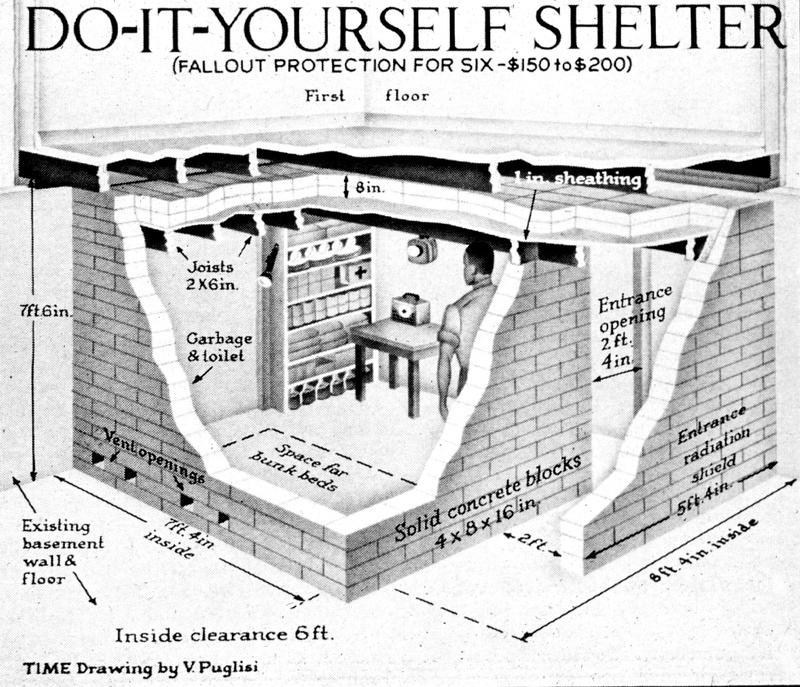
Fallout
Both simple fission devices and multi-stage fission-fusion-fission devices are driven by, and produce, an intense flux of neutrons.
Material vaporized in the intense heat of a nuclear explosion is exposed to this neutron flux. Its atomic nuclei absorb neutrons and become heavier and unstable, through a process called neutron activation.
This newly radioactive material condenses into fine dust and light sandy material that falls out of suspension. This fallout contains heavier and less stable atomic nuclei, which immediately begin decaying and emitting alpha particles, beta particles, and gamma rays.
The Fallout Shelter Craze
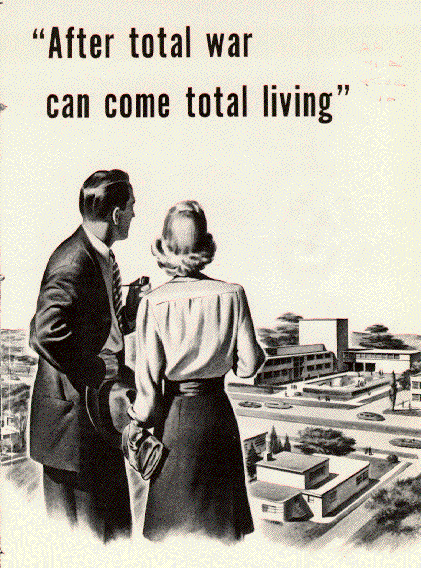
U.S. President John F Kennedy gave an address in Berlin in July 1961. He called for citizens to take the necessary steps to protect themselves and their families from a possible nuclear confrontation with the Soviet Union.
The next month, August 1961, the Berlin Wall went up.
The September 15, 1961, issue of Life magazine included a letter from Kennedy to the U.S. people, along with a large section with civil defense advice for the nation. It had a basic plan for a fallout shelter, and gave the address where citizens could write to the OCD or Office of Civil Defense and request more information. That same month the federal government began the Community Fallout Shelter Program.
By September, fallout shelter sales were well underway. Sears, Roebuck and Company offered shelter kits. Shelter companies appeared as if out of no where. Newsweek reported that during the first week of September 1961, thirty shelter firms had been created in Atlanta. None were approved by the OCD. From July to December 1961, the number of OCD-approved shelter distributors increased from 51 to 351, and others calling themselves survival specialists grew into the thousands.
You could buy prefabricated units, assemble them, and bury them on your property. Before long there were door-to-door fallout shelter salesmen. Consumer Reports found that 200,000 home fallout shelter kits were sold in 1961 and 1962. They assumed that many more were quietly built from plans, with the owners keeping them secret from neighbors. 200,000 sounds like a lot, but the U.S. population at the time was about 180,000,000. On a per-capita basis, shelters were very uncommon.
Historians typically define the short "shelter craze" as lasting from the Berlin Crisis in August, 1961, to the end of atmospheric nuclear weapons testing in 1963.
People soon tired of the fallout shelter salesmen. Preparing to survive nuclear war seemed absurd and pointless. The salesmen knew almost nothing about radiological shielding or construction. They and their companies were seen as unethical war profiteers taking advantage of public fear and uncertainty.
A swimming pool company in Las Vegas rebranded itself as a shelter company, and sold unwary buyers upside-down swimming pools.
A firm in Philadelphia was selling shelters without any ventilation or air filter. If the buyer managed to assemble one, which was unlikely, it would asphyxiate anyone seeking shelter inside.
Building regulations in Portland required all structures to have windows, so firms there sold so-called "shelters" with windows that would provide dramatic views of the fireballs with unimpeded passage of the gamma rays.
The government was asking the public to buy and build shelters to protect themselves, in a "Consumers' Republic". The public started wondering why the government wasn't doing anything for them, including policing the increasingly crooked shelter industry.
In the early 1950s, U.S. Civil Defense literature had described home shelter construction as a quasi-military activity, your family being both civilians and soldiers after a fashion.
During the 1961-1963 shelter craze, the shelter salesmen pitched their shelters as an added recreational space. A hobby room, a recreation room, something for fun and relaxation. Constructing one was sold as a masculine activity, like building a workshop or assembling and using a large barbeque grill. Plus, you were doing your patriotic duty by buying a shelter kit from one of the vendors. It was Citizenship through Consumerism.
However, instead of heroic citizen-soldier consumers buying and building their own military-grade shelters, potential shelter buyers were confused and skeptical. Those who bought faulty shelters couldn't assemble them, because no one could.
The physical requirements and cost meant that only fairly affluent families living in suburbs or small towns could have a useful shelter.
So, only a certain class of white people would be saved.
As early as November, 1961, one of Kennedy's advisors explained that "shelter ownership has turned ugly." The Kennedy administration provided funding for public shelters in public buildings including schools and hospitals.
By the summer of 1962, one year into the shelter craze, both the OCD and Consumer Reports considered the shelter industry to be dominated by "fly by night" firms with "suede shoe" salesmen. Swimming pool firms and car dealers were presenting themselves as radiological shelter experts. Shelter salesmen in several cities were posing as civil defense officials. While government officials didn't comment on the class and racial inequality of the shelter situation, journalists did.
By the time of the Cuban Missile Crisis in October, 1962, shelter owners were attracting criticism. There were reports of men stockpiling weapons and ammunition in their shelters. One journalist described it as the "evil of each family for himself and the devil take the hindmost."
By early 1963, an estimated six hundred shelter companies across the U.S. had filed for bankruptcy.
"The Struggle to Sell Survival: Family Fallout Shelters and the Limits of Consumer Citizenship"See the paper "The Struggle to Sell Survival" for a fascinating analysis of how public interest initially surged but quickly fell. It was the source of many of the above details.
By the 1970s the U.S. federal government ended funding for public fallout shelters. The yellow and black signs remained in place, especially in New York City, for decades, while the former shelters were converted into laundry rooms and storage areas, and the stored food and medicines removed.
Amazon
ASIN: 162534483X
Amazon
ASIN: 0814775233
A Surviving Fallout Shelter
Some early 1960s fallout shelters remain today. Here is one still in place in 2020.
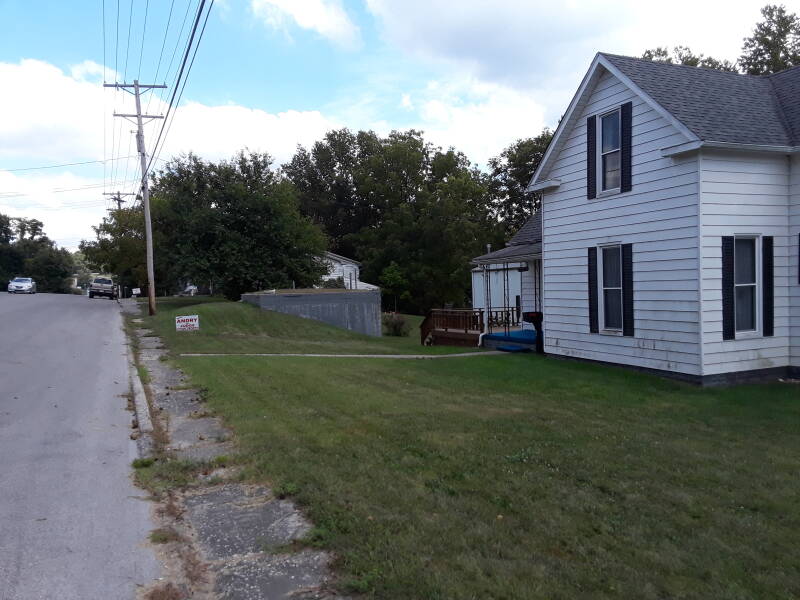
It's about 50% below ground, with soil on its roof.
The soil would provide some shielding, although you would have to deal with roots trying to make their way into the structure.
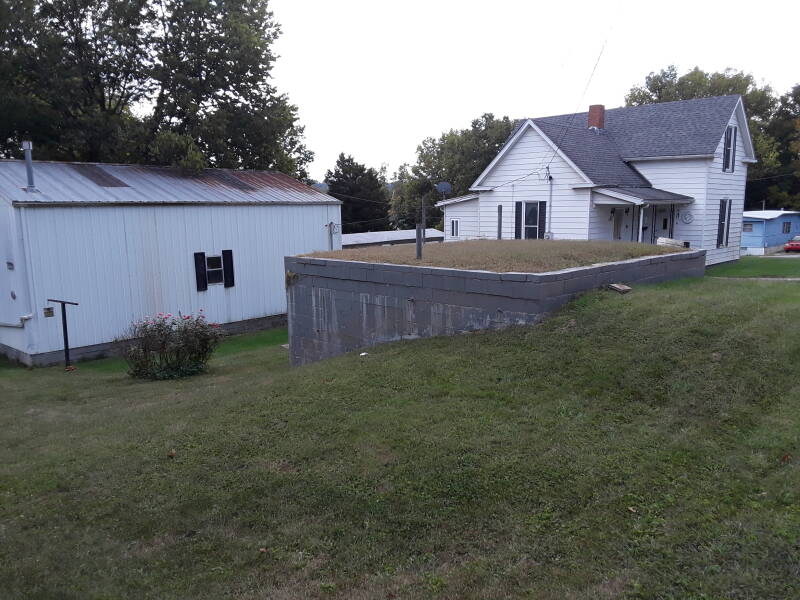
The U.S. Government published guidelines for general construction techniques and radiological shielding.
Fallout material emits gamma rays and charged alpha and beta particles.
An alpha particle is two protons and two neutrons bound into a particle identical to an ordinary helium nuclei. It's a large particle, and so it is stopped by the outer layer of dead cells in your skin. However, if you breath alpha-emitting dust into your lungs, or consume water or food contaminated by it, alpha particles are especially damaging. This is why radon gas is dangerous — it's an intermediate step in the radioactive decay chains in which uranium and thorium gradually decay into lead. Radon is the heaviest noble gas, and can accumulate in low confined spaces like basements. It decays quickly, emitting an alpha particle. In your lungs, the tissues are not protected by an outer layer of dead skin cells. The alpha particles damage chromosomes within lung cells, leading to lung cancer.
A beta particle is a high-energy, high-speed electron or positron. Average to heavy clothing provides almost complete protection, as does a thin aluminum sheet.
Amazon
ASIN: B086HVZS54
Amazon
ASIN: B00285K1EK
Gamma radiation is electromagnetic radiation at the highest-frequency, highest-energy end of the electromagnetic spectrum. Gamma radiation overlaps with the highest energy X-rays, extending even further in frequency and energy. Gamma rays vary in energy, and thus in the amount of shielding needed, but gamma ray shielding must be much greater than that for the charged particles. Gamma rays are best absorbed by material with high atomic number and high density.
A typical example is that 1 cm of lead can reduce a certain energy level of gamma ray intensity by 50%, The same 50% reduction would require 4.1 cm of granite, or 6 cm of concrete, or 9 cm of packed earth.
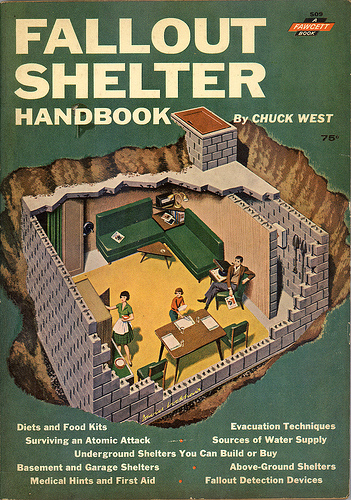
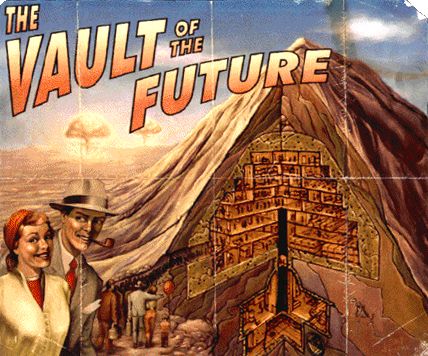
Looking Inside
These pictures were taken in 1995, when a couple bought the property along with its fallout shelter.
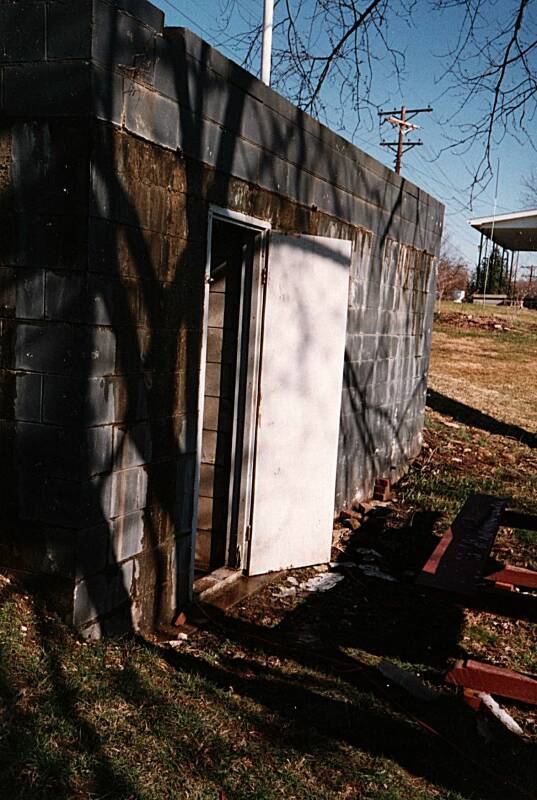
Here they are with their new purchase.
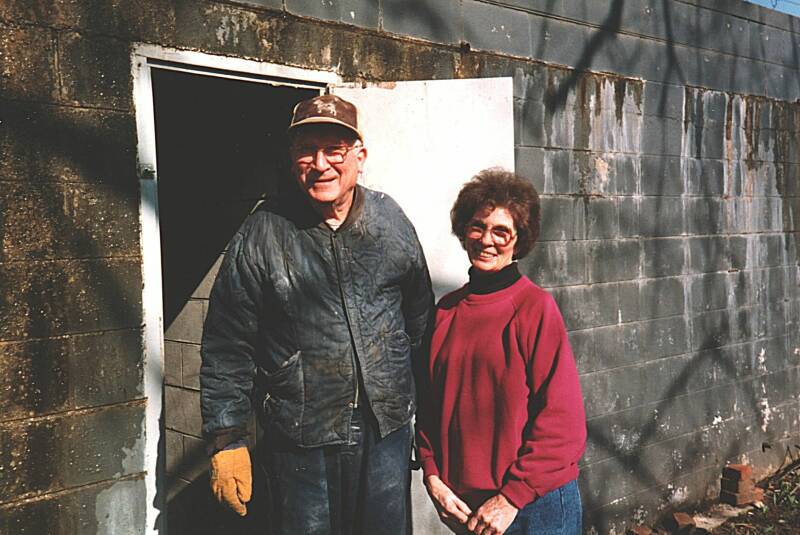
The interior had a partially collapsed set of shelves holding decades-old canned food. Yum.
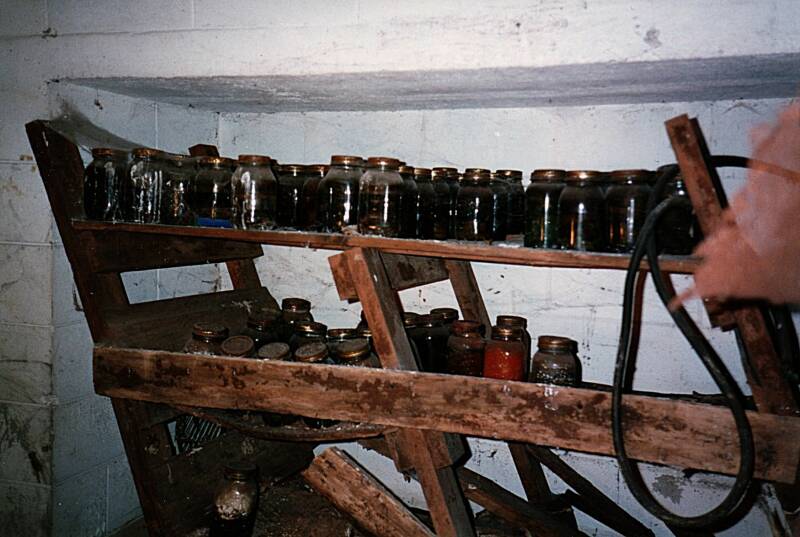
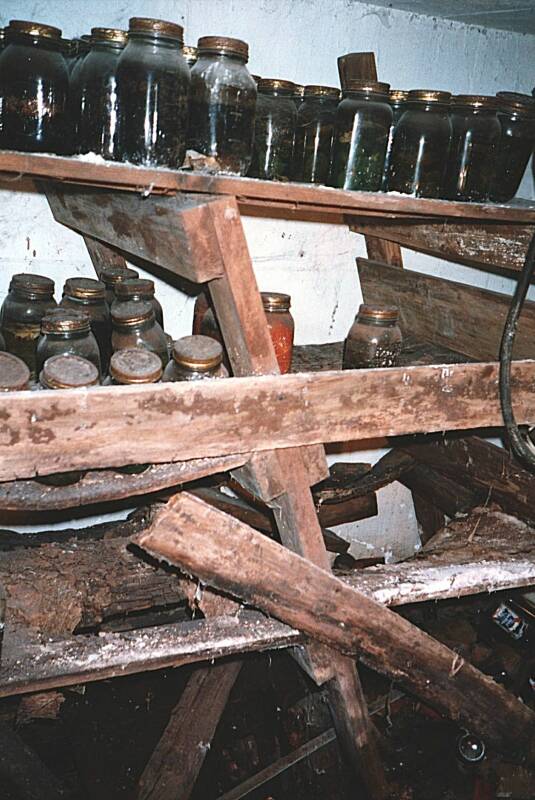
When you're stuck inside a fallout shelters for at least three to five weeks, of course you will wish you had a conventional toilet and running water.
However, whoever designed this fallout shelter had far too much trust in the survivability of small town water supply and sewage treatment systems.
Here it is, the Toilet of Doom, next to the Sink of Doom.
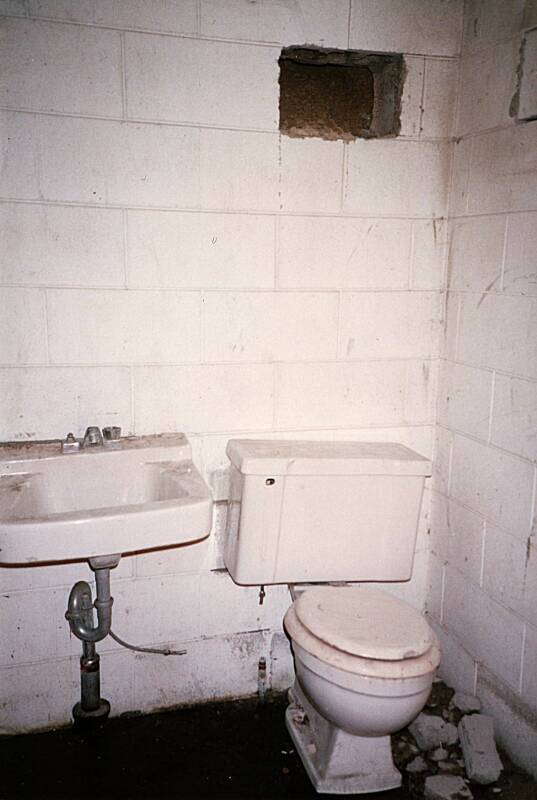
A fallout shelter would really need a composting toilet or chemical toilet. Something you would put on a boat, not in a house.
The small electrical panel would probably be like the plumbing — handy when the fallout shelter wasn't really in use, but rather pointless during a nuclear war.
Amazon
ASIN: B000I0ED8W
Amazon
ASIN: B0045HCJRG
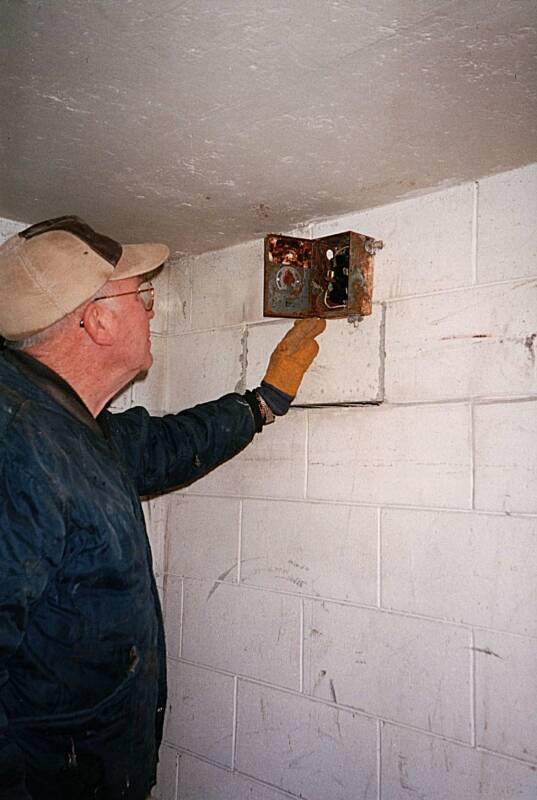
The most dangerous fallout is material similar to sand or finely ground pumice. Minimal filtering is needed for the ventilation, just enough to keep out sizable dust and larger particles.
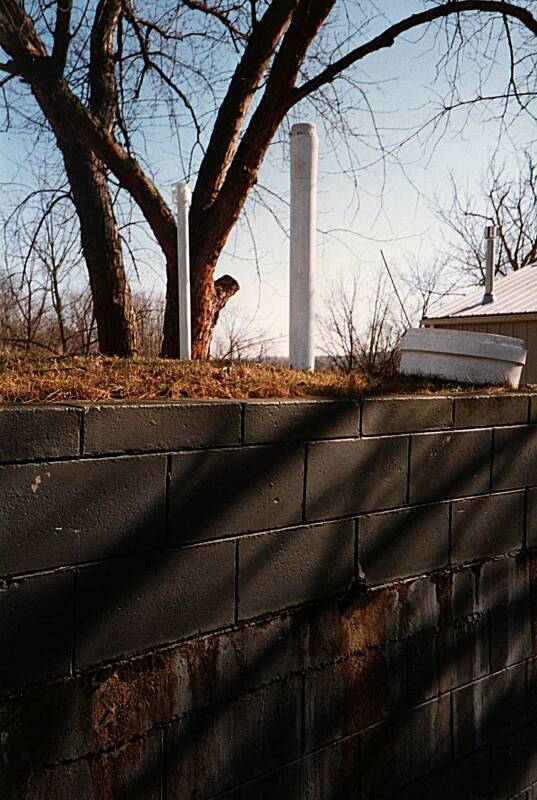
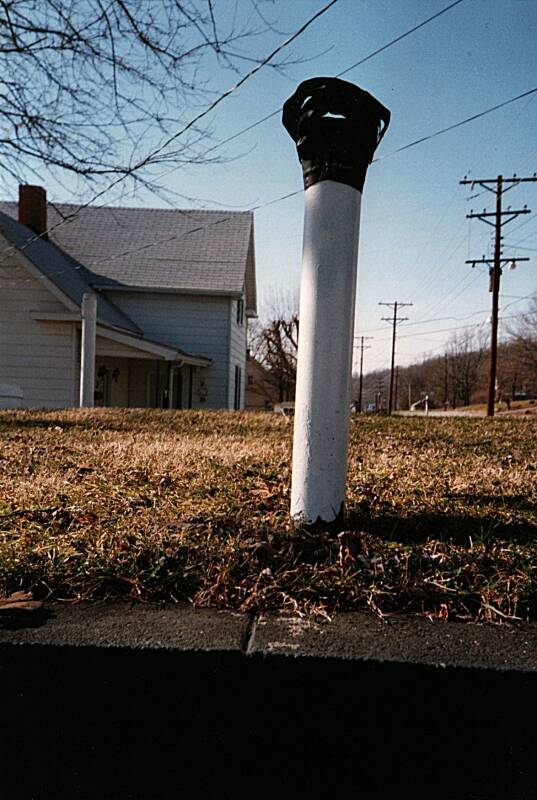
A Sani-Flush blue border indicates a toilet, sink, shower, or other plumbing that I've used.
The Toilet Guru's travel suggestions
Now some lurid advertisements from Google AdSense:
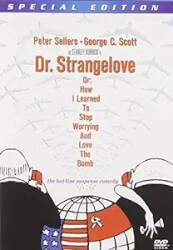

 To the Main Page
To the Main Page